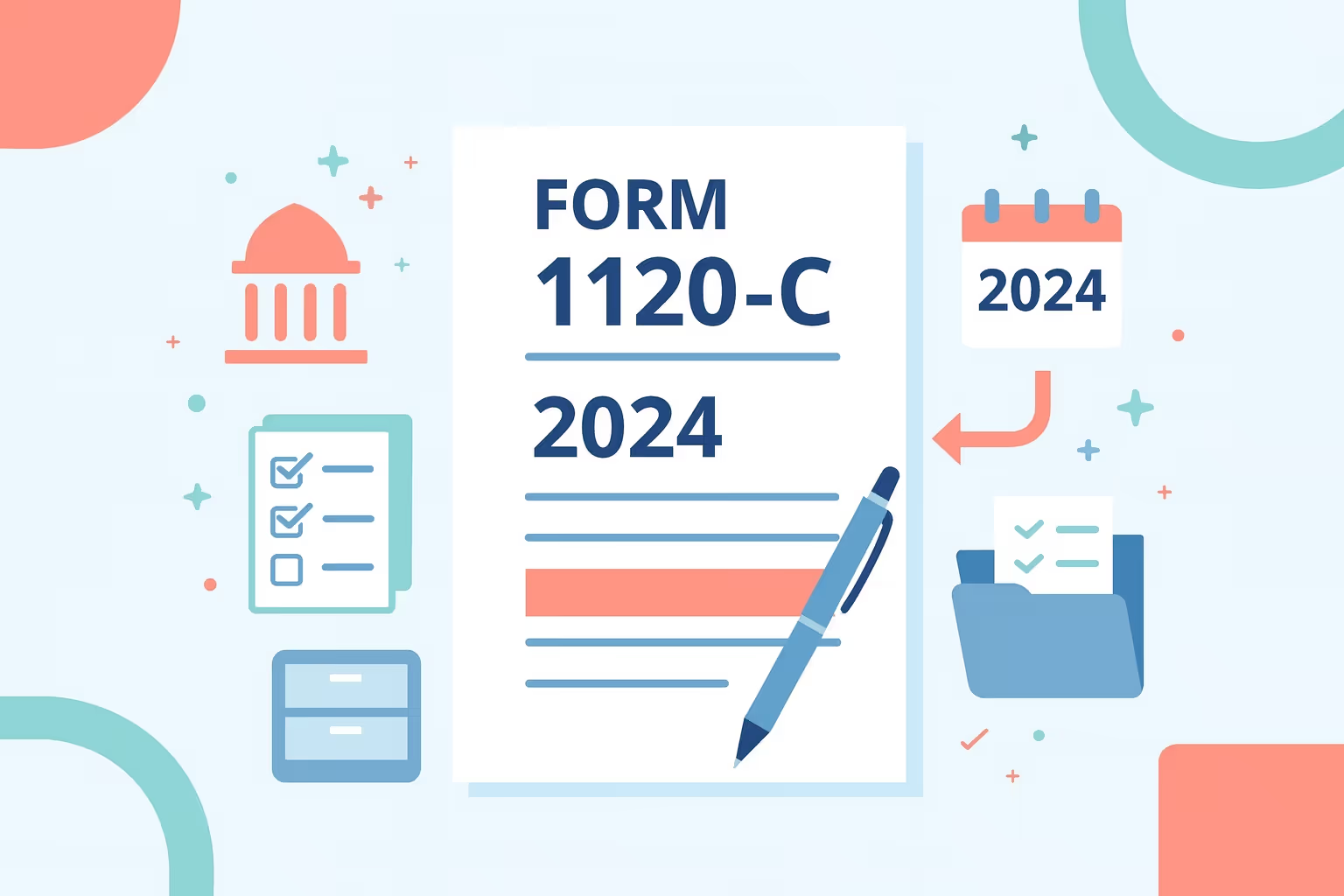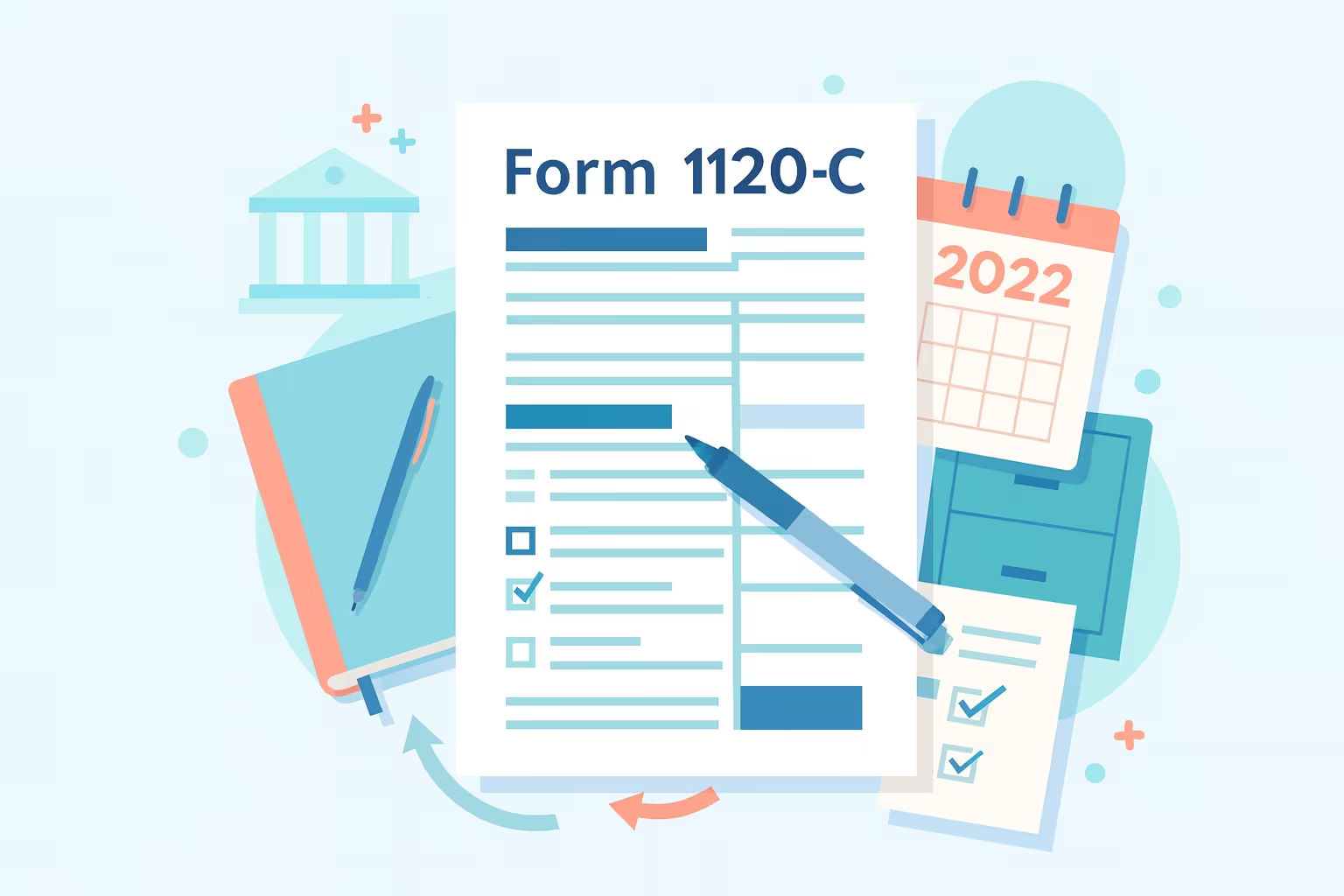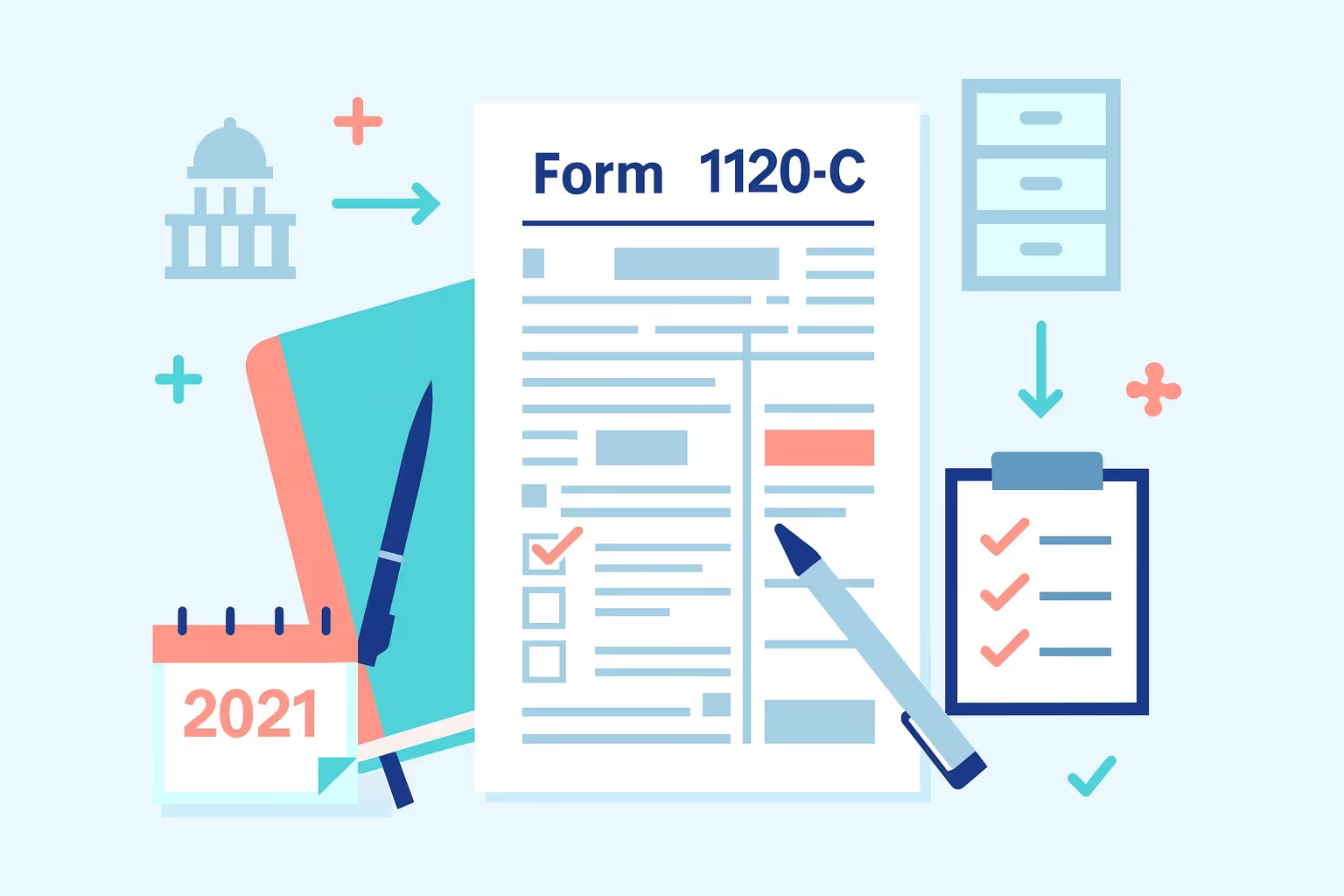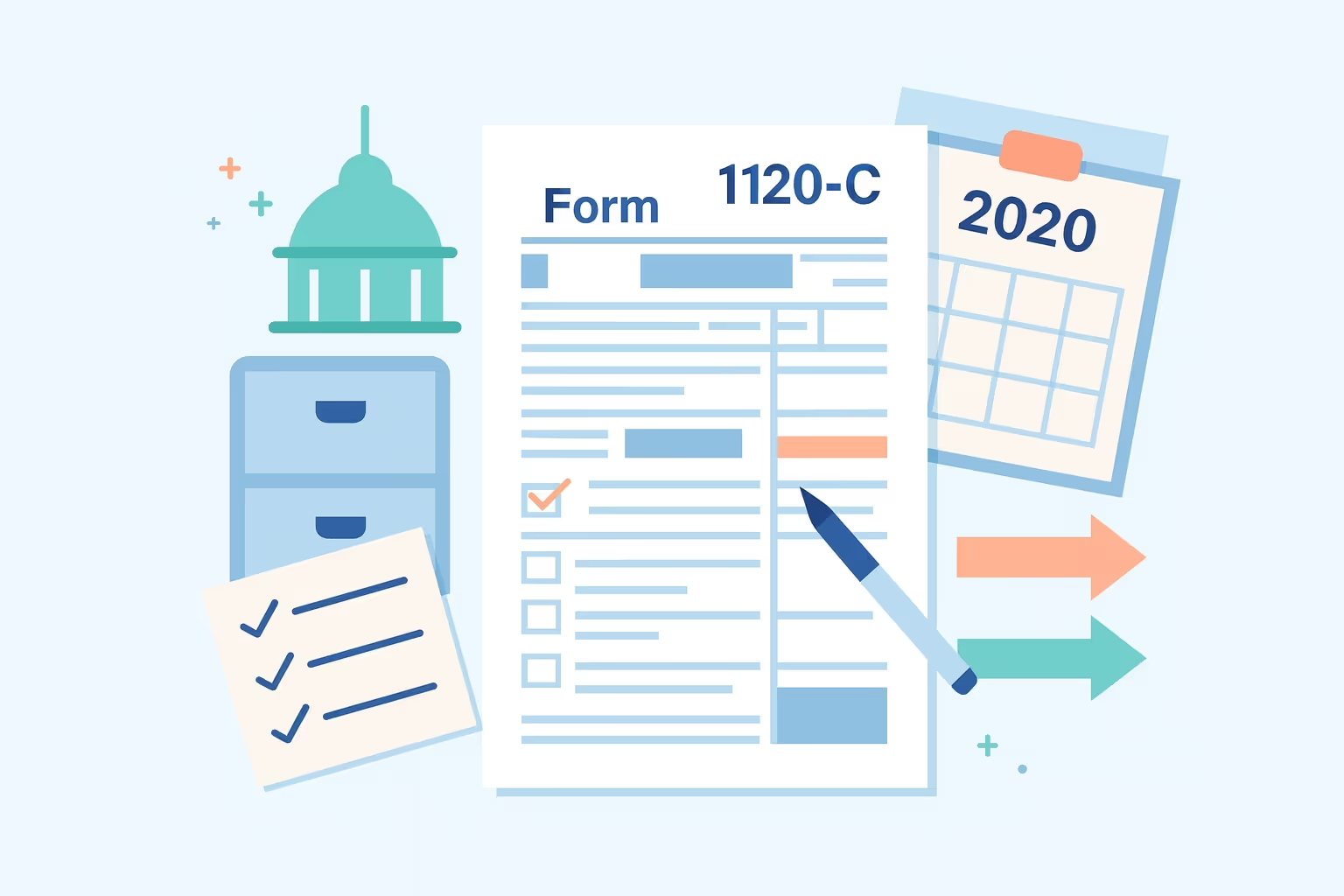
Filing an income tax return can feel complex for organizations operating on a cooperative basis under the Internal Revenue Code. Form 1120-C serves as the official federal income tax return for member-owned corporations, including farmers’ cooperatives, credit unions, and utility cooperatives. It is used to report income, deductions, credits, and other details that help determine overall income tax liability. For the 2012 tax year, specific reporting guidelines were put in place to help organizations calculate taxable income while maintaining eligibility for tax-exempt income or special deductions.
Cooperatives must complete Form 1120-C carefully to meet their compliance responsibilities. Whether an organization has tax-exempt status or operates as a taxable corporation, each filer must carefully identify its revenue sources, including both patronage and non-patronage activities. Each cooperative must include supporting financial statements to verify reported figures, document expenses, and confirm compliance with IRS regulations. This approach helps confirm the cooperative’s eligibility for exemptions, credits, and benefits permitted by law.
This guide explains how to prepare, review, and file Form 1120-C for the 2012 tax year. According to the official IRS Form 1120-C (2012) instructions, organizations must disclose relevant financial data, including per-unit allocations and qualified written notices, to maintain compliance and accurately determine tax liability.
Understanding Form 1120-C and Who Must File
Corporations operating cooperatively under the Internal Revenue Code must file Form 1120-C to meet federal reporting requirements. This income tax return applies to organizations that allocate profits to members or patrons based on their level of participation in the organization.
Filing ensures compliance with tax laws governing cooperative associations, proper income and expenses disclosure, and accurate income tax liability calculation. Meeting filing obligations helps cooperatives maintain eligibility for exemptions and ensures transparent financial reporting.
Eligibility and Filing Requirements
- Operate on a Cooperative Basis: Organizations must operate under Internal Revenue Code Section 1381, providing goods, services, or marketing support primarily for members.
- Member-Owned Corporations: Qualified entities include farmers’ cooperatives, credit unions, and utility cooperatives. These organizations distribute income to members based on patronage rather than stock ownership.
- Annual Filing Obligation: Each cooperative must submit an income tax return even if no taxable income, profit, or financial activity occurred during the year. Consistent filing protects cooperative status.
Filing Status and Structure
- Farmers’ Cooperatives: Agricultural groups that market members’ products or supply goods to members may qualify for limited exemptions. They must separately disclose patronage dividends, per-unit retains, and non-patronage revenue.
- Non-Exempt Cooperatives: Organizations without tax-exempt status must report all gross receipts, allowable expenses, and applicable deductions.
- Multiple Activity Reporting: Cooperatives engaged in both exempt and taxable operations must distinguish between qualifying and non-qualifying revenue when determining tax liability.
Key Filing Components
- Employer Identification Number (EIN): Each filer must include its EIN to verify identity and ensure accurate processing.
- Disclosure Requirements: Cooperatives must accurately report their total income, cost of goods sold, credits, and deductions to determine taxable income.
- Filing Timeline: Returns are generally due on the 15th day of the ninth month following the end of the fiscal year, though fiscal-year entities may have different deadlines.
Preparing an accurate return demonstrates compliance with federal regulations and maintains cooperative accountability. Filing consistently annually ensures alignment with IRS expectations and supports continued eligibility for tax benefits.
Cooperatives that understand these requirements can organize their records accurately, calculate taxable income precisely, and complete Form 1120-C with confidence. These steps establish a foundation for long-term compliance and financial transparency.
Key Components of the 2012 Form
Form 1120-C for tax year 2012 contains several key sections that help cooperative associations report income, deductions, and credits in compliance with the Internal Revenue Code. Each part of the return is designed to capture detailed financial information from organizations operating on a cooperative basis. Reviewing each component ensures precise and accurate reporting, supports eligibility for exemptions, and confirms that taxable income is correctly calculated.
Main Return Overview
The main section of Form 1120-C summarizes gross receipts, cost of goods sold, deductions, and taxable income. It establishes the cooperative’s income tax liability and ensures that income derived from member and non-member transactions is appropriately recorded. Cooperatives must include information about credits, interest income, and other relevant financial activities. Each figure must be supported by financial statements that reflect accurate accounting practices and procedures.
Required Schedules and Attachments
The 2012 version of Form 1120-C includes several schedules that provide additional information beyond the primary return.
- Schedule C: Records dividend income, special deductions, and other investment-related details.
- Schedule G: Distinguishes between patronage and non-patronage income, clarifying which transactions qualify for cooperative tax treatment.
- Schedule H: Reflects adjustments and deductions allowed under Internal Revenue Code Section 1382.
- Schedule J: Calculates the organization’s total tax liability, including applicable credits and estimated tax payments.
- Schedule L: Reports the cooperative’s balance sheet per books, ensuring that assets, liabilities, and retained earnings align with its financial statements.
- Schedules M-1 and M-3: Reconcile the differences between book income and taxable income, providing transparency in how income is determined.
Supporting Documentation and Accuracy
Supporting documentation strengthens the reliability of the information reported on Form 1120-C. Cooperatives must attach detailed statements explaining income sources, expense allocations, and credit computations. Records should identify all relevant financial transactions, including those involving per-unit retains, member services, and other property exchanges. Consistent reporting enhances compliance with federal tax regulations and reduces the likelihood of review.
Each component of Form 1120-C works together to present a complete picture of a cooperative’s financial position and tax obligations. Understanding how these sections interact enables organizations to prepare a return that meets federal standards. Thorough preparation ensures transparency, reinforces cooperative accountability, and establishes a clear foundation for future filings.
Reporting Patronage Dividends and Income
Cooperative associations use Form 1120-C to disclose all patronage-related income earned during the tax year. Patronage income represents revenue generated from business activities conducted with or for members on a cooperative basis.
These transactions typically include marketing members’ products, purchasing goods or services on their behalf, or providing other collaborative activities that directly benefit members. Proper reporting of these earnings ensures compliance with federal tax regulations and supports the accurate determination of income tax liability.
Patronage dividends represent the amounts allocated to members in proportion to their level of business participation within the cooperative. These distributions often include cash payments, qualified written notices, or property transfers. Each type of distribution must be recorded in the cooperative’s accounting records and reported on the income tax return.
Cooperatives should accurately classify these amounts to ensure they qualify as deductible expenses, thereby reducing taxable income while maintaining compliance with Internal Revenue Code Section 1382. If a cooperative does not document patronage distributions properly, it may lose its eligibility for specific exemptions and credits.
When preparing the income tax return, organizations should identify and separate patronage-related activities from other transactions. Key reporting practices include:
- Clearly classify income sources: Distinguish revenue earned from member-related operations and non-member activities to ensure accurate reporting.
- Record qualified written notices: Include the value of each notice, specifying amounts distributed in cash and retained as equity.
- Verify per-unit retains: Track amounts withheld from member proceeds to fund cooperative operations and confirm proper allocation.
- Attach supporting financial statements: Provide documentation verifying income totals, expense allocations, and dividend distributions.
- Verify compliance with Section 1382: Ensure all reported deductions and credits align with Internal Revenue Code requirements.
Each cooperative must also disclose the timing and method used to distribute patronage dividends. Many organizations issue qualified written notices that specify the amount of cash distributed and the portion retained for equity purposes. To qualify for a deduction in the same tax year, these notices must meet the requirements of the Internal Revenue Code.
Maintaining accurate records of each notice, including recipient information and distribution values, demonstrates compliance and strengthens audit readiness. Cooperatives should also track related expenses, ensuring that only allowable deductions are deducted from taxable income.
Reporting patronage dividends correctly demonstrates transparency and reinforces trust between members and management. It also ensures that the cooperative’s income tax return accurately reflects earnings from member-related activities. Clear documentation, precise classification, and adherence to statutory requirements enable cooperatives to maintain compliance, accurately determine taxable income, and remain eligible for applicable tax benefits.
Handling Non-Patronage Income and Capital Gains
Non-patronage income represents revenue from activities unrelated to a cooperative’s core member services. These earnings typically arise from transactions with non-members or business ventures outside the cooperative’s usual operations.
Correctly reporting this income ensures accurate calculation of taxable income and compliance with the Internal Revenue Code. Cooperatives must maintain separate records for member and non-member activities to confirm that each source of income receives correct tax treatment and disclosure on the income tax return.
Non-patronage income can include investment gains, interest earnings, or proceeds from property sales. Because these revenues are not derived from member-based transactions, they are fully taxable and may not be offset through patronage deductions. Accurate classification prevents errors that could affect overall income tax liability.
Cooperatives should thoroughly document all related activities, identifying each source and aligning it with the applicable accounting records. The Internal Revenue Code requires clear separation between patronage and non-patronage income to ensure compliance with federal reporting standards.
Typical forms of non-patronage income include:
- Investment Earnings: Returns on securities, deposits, or other holdings not directly linked to member operations.
- Rental Revenue: Proceeds from leasing property, equipment, or facilities to non-members.
- Interest Income: Payments earned from financial instruments or credit activities unrelated to cooperative services.
- Capital Gains: Profits realized from selling business property or other long-term assets.
- Other Commercial Activities: Revenue from marketing, purchasing, or service arrangements not involving members.
When reporting capital gains or losses, cooperatives must complete Form 8949, which details the sale or exchange of capital assets. The totals from Form 8949 are transferred to Schedule D of Form 1120-C to calculate the net gain or loss.
The Form 8949 (Sales and Other Dispositions of Capital Assets) page outlines the steps for documenting each transaction, including the date of acquisition, the date of sale, the proceeds, and the cost basis. Accurate reporting ensures that taxable income reflects financial activity and meets IRS documentation standards.
Maintaining precise records of non-patronage transactions helps cooperatives avoid misclassification and ensures proper separation of taxable income categories. Distinguishing non-member revenue from member-based operations supports transparency and regulatory compliance. By accurately recording capital gains and unrelated earnings, cooperatives can confidently determine their total tax liability and maintain federal reporting integrity.
Completing Balance Sheets and Reconciliation Schedules
Completing balance sheets and reconciliation schedules is critical for cooperative associations filing Form 1120-C. These schedules verify the organization’s financial position, confirm the accuracy of reported income and expenses, and ensure that accounting records align with tax reporting requirements. Each cooperative must confirm that its financial statements support the figures reported on the income tax return, demonstrating consistency and transparency throughout the filing.
- Schedule L – Balance Sheets per Books: This schedule presents the cooperative’s financial position at the beginning and end of the tax year. It must include all assets, liabilities, and equity, reconciling totals with the organization’s general ledger. The amounts listed should correspond with audited or reviewed financial statements to maintain accuracy.
- Schedule M-1 – Book-to-Tax Reconciliation (Assets Under $10 Million): Cooperatives with total assets below $10 million must complete Schedule M-1 to explain differences between book income and taxable income. Adjustments may include non-deductible expenses, deferred revenue, or timing differences between financial and tax reporting. Proper reconciliation ensures that all temporary and permanent differences are correctly reflected.
- Schedule M-3 – Detailed Reconciliation (Assets $10 Million or More): Large cooperatives must file Schedule M-3, which provides a more detailed breakdown of reconciling items. This schedule enhances transparency, requiring specific line-item reporting for income, expenses, and adjustments that differ between book and tax records.
- Supporting Documentation: Cooperatives must support every reconciliation with financial statements, workpapers, and schedules identifying significant differences. Supporting records confirm that reported totals align with internal accounting systems and substantiate deductions or credits claimed.
- Review and Verification: Before submission, cooperatives should review each reconciliation entry to confirm accuracy. Comparing reported amounts with underlying documentation minimizes the risk of discrepancies that may trigger IRS inquiries.
Reconciliation schedules serve as an essential link between accounting records and the income tax return. Completing them correctly strengthens the cooperative’s financial credibility and ensures compliance with federal regulations.
Consistent preparation also facilitates future reporting, enabling organizations to track year-over-year changes in assets, liabilities, and equity. A thorough and accurate approach to these schedules reinforces confidence in the cooperative’s financial integrity and readiness for examination.
Filing Requirements and Step-by-Step Process
Filing Form 1120-C for tax year 2012 requires careful preparation, complete documentation, and compliance with Internal Revenue Code provisions. Cooperatives must ensure all financial data is accurate, schedules are attached in the correct order, and reporting aligns with their accounting records.
Each step in the filing process plays a vital role in calculating taxable income, verifying deductions, and determining income tax liability. Following a structured approach simplifies compliance and minimizes the risk of errors during the submission process.
Step 1: Gather Essential Records
Collect all necessary financial statements, general ledgers, and supporting schedules. Include documents reflecting income, expenses, per-unit retains, and distributions to members. Prior-year tax returns should be available for reference to confirm consistency in reporting methods and carry-forward items.
Step 2: Verify Entity Information
Confirm the cooperative’s legal name, address, and Employer Identification Number (EIN). Ensure the entity classification under the Internal Revenue Code remains accurate, whether operating as a farmers’ cooperative, credit union, or utility cooperative. Verifying these details helps maintain eligibility for any tax-exempt income or special deductions.
Step 3: Report Income and Deductions
Enter all patronage and non-patronage income, including capital gains, interest, and other property transactions. Record allowable deductions such as wages, rent, depreciation, and charitable contributions. Reporting these amounts correctly ensures proper calculation of taxable income.
Step 4: Complete Required Schedules
Attach all mandatory schedules, including those for dividends, special deductions, and balance sheets. Ensure that each schedule corresponds with the figures listed on the primary income tax return. Review each attachment for accuracy and completeness before finalizing.
Step 5: Calculate Tax Liability and Credits
Use the tax computation schedule to determine the cooperative’s total income tax liability. Apply any available credits to reduce the balance due. Verify that estimated tax payments made during the year are reflected correctly in the total payment section.
Step 6: Review, Sign, and File the Return
Review all entries for accuracy and consistency. The authorized officer must sign and date the return before submitting it. Cooperatives may file electronically or mail paper returns, depending on their filing preferences and eligibility.
A disciplined filing process supports accuracy, reduces reporting discrepancies, and ensures compliance with federal tax requirements. Maintaining a structured approach from preparation through submission enables cooperatives to meet deadlines confidently and sustain transparency in financial reporting.
Extensions, Payments, and Compliance Safeguards
Cooperative associations filing Form 1120-C may occasionally need more time to prepare their income tax return. The Internal Revenue Code allows eligible corporations to request an extension of time to file without delaying payment obligations. An extension grants additional time to finalize schedules, reconcile financial statements, and review supporting documentation, ensuring the return reflects accurate income, expenses, and credits.
Purpose and Scope of a Filing Extension
An extension grants extra time to file but does not postpone payment of the tax liability. Cooperatives must estimate and pay the full balance due by the original deadline to avoid interest charges. Filing Form 7004 allows organizations to extend the submission date and maintain compliance while finalizing their financial records.
The IRS Form 7004 (Extension of Time to File) resource outlines eligibility requirements, submission deadlines, and completion steps. Proper use of Form 7004 ensures a cooperative remains in good standing and avoids late-filing consequences.
Filing Payments and Meeting Tax Deadlines
Electronic payment methods offer a secure and efficient way to meet federal tax obligations. Cooperatives may submit payments through the Electronic Federal Tax Payment System (EFTPS), same-day wire transfers, or automated bank withdrawals.
To ensure accurate posting, each transaction must include the correct Employer Identification Number (EIN) and tax period. The IRS requires all estimated tax payments and balance dues to be submitted electronically to confirm receipt and maintain compliance.
Timely payment prevents interest accrual and reduces exposure to compliance issues affecting financial reporting. Cooperatives expecting to owe at least $500 in income tax liability must make quarterly estimated payments during the tax year.
Payment deadlines typically fall on the 15th day of the fiscal year's fourth, sixth, ninth, and twelfth months. Adhering to these schedules demonstrates fiscal discipline and reinforces the cooperative’s commitment to accurate tax management.
Frequently Asked Questions
What is the purpose of filing an income tax return for a cooperative association?
Filing an income tax return ensures that a cooperative reports all income, expenses, and deductions accurately under the Internal Revenue Code. The return establishes the cooperative’s total income tax liability and confirms compliance with federal tax requirements. It also documents activities conducted on a cooperative basis, including patronage and non-patronage operations. Accurate filing supports eligibility for exemptions, credits, and deductions available to qualifying organizations.
How should a cooperative report per unit be retained on Form 1120-C?
Per-unit retains represent amounts withheld from members’ proceeds to finance operations or meet capital needs. Cooperatives must report these figures on the income tax return as part of their patronage allocations. Proper classification distinguishes per-unit retains from other types of income and ensures compliance with cooperative tax regulations. Maintaining detailed records and documentation supports accurate totals and aligns with the cooperative’s accounting system.
Which persons are responsible for signing and submitting Form 1120-C?
The cooperative’s president, treasurer, or other principal officer must review, sign, and date the income tax return before submission. Authorized persons ensure that all schedules and statements reflect accurate information supported by internal financial records. Their signature certifies that the cooperative prepared the return in accordance with IRS requirements. Retaining a signed copy with supporting documentation demonstrates accountability and helps resolve any questions that may arise after filing.
How do developments related to cooperative taxation affect annual filings?
Developments related to cooperative taxation can influence reporting procedures, deduction eligibility, or treatment of specific transactions. Cooperatives must stay informed of current updates to ensure compliance with changes to the Internal Revenue Code. Adjustments may affect how organizations classify per-unit retains, record member distributions, or claim tax credits. Reviewing IRS updates and consulting qualified professionals ensures returns reflect current law and reporting standards.
What forms of withholding apply to cooperative employees?
Cooperatives with employees must withhold federal income tax, Social Security, and Medicare contributions from wages. Withholding obligations also include depositing employer-matching contributions and submitting regular payroll reports. These payments represent money owed to the government for employee-related tax liabilities. Maintaining compliance with withholding requirements prevents potential discrepancies between payroll and reported expenses on the income tax return.
Can cooperatives claim deductions for other types of income?
Yes, cooperatives may claim deductions for ordinary and necessary expenses associated with generating other types of taxable income. These may include interest, rent, and depreciation costs incurred during operations. Each deduction must directly relate to income reported on the return and comply with IRS guidelines. Maintaining accurate documentation and precise expense categorization supports eligibility for claimed deductions and strengthens audit readiness.
Where can cooperatives find the official IRS filing guidance for preparing Form 1120-C?
Cooperatives can refer to the official IRS publication, which contains detailed filing guidance for completing Form 1120-C. The guide explains line items, schedules, and documentation requirements for accurate reporting. It also clarifies how to record per-unit retains, classify income types, and determine applicable deductions. Reviewing these resources ensures compliance, supports consistent reporting practices, and helps cooperatives fulfill their federal income tax obligations.
























